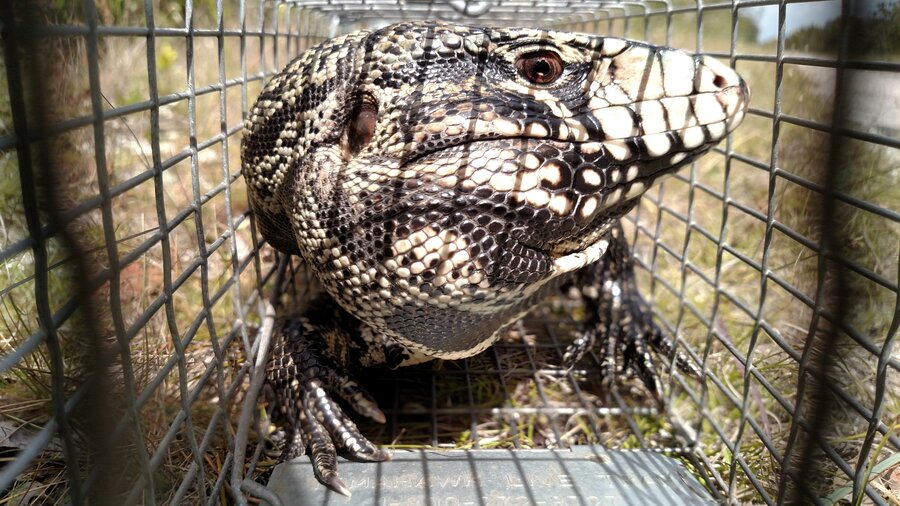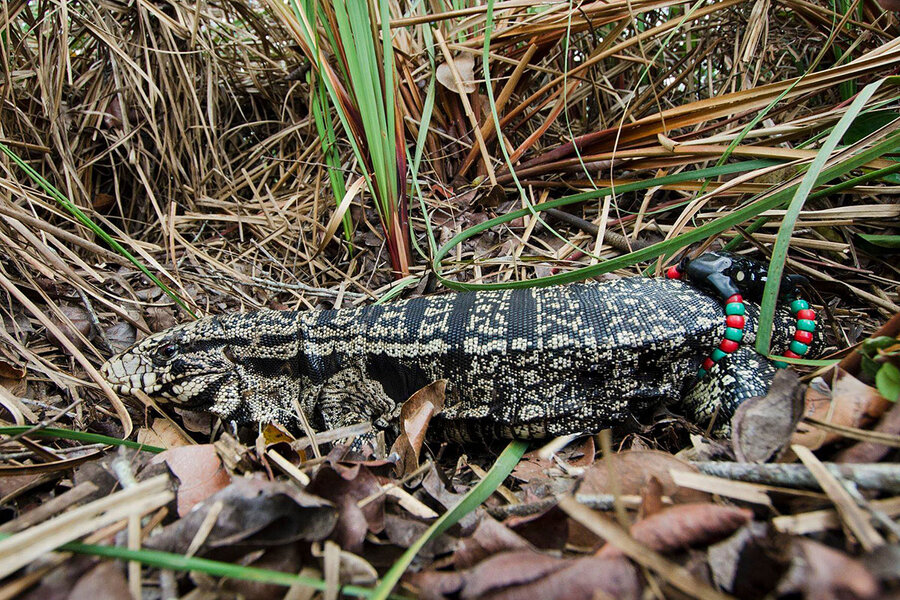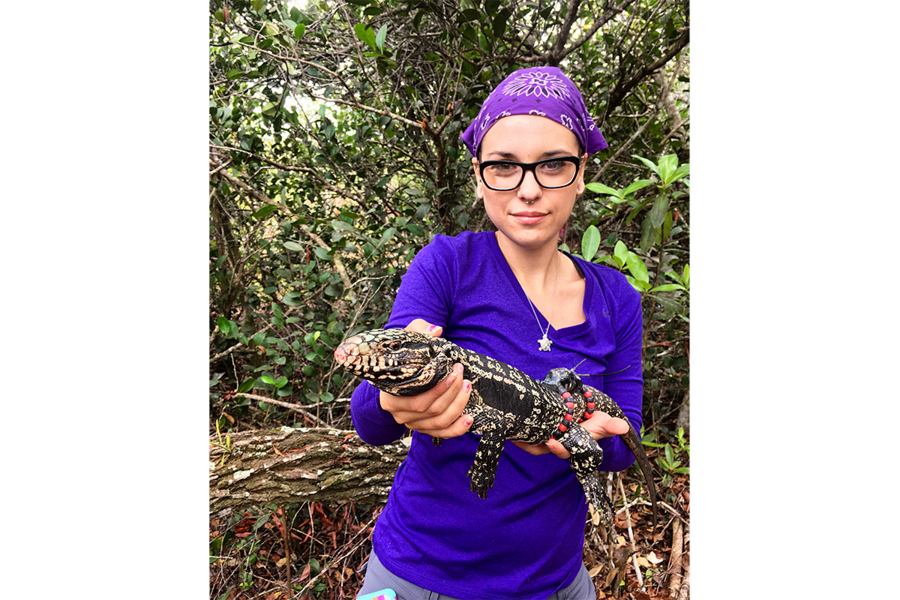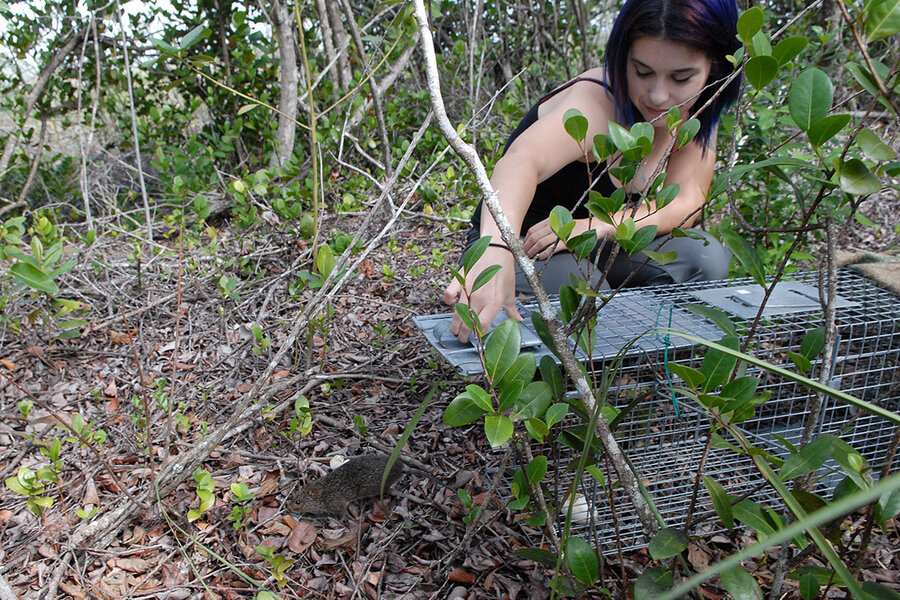How Florida fends off its slippery, scaly invaders
Loading...
| Southern Glades Wildlife and Environmental Area, Fla.
As the pickup truck slowly bumps down the dirt road, radio static fills the cab. The scientists subdue their chit-chat and perk up their ears for the signal. Then, it comes. A muted chirp breaks the static. "There she is!" says Sarah Cooke, a graduate student on the University of Florida's Croc Docs wildlife research team.
“She” is number 858, an Argentine black and white tegu lizard nicknamed “Furiosa” by a former lab intern, for the way she flailed when the scientists first captured her and outfitted her with an electronic tracking backpack.
The chirps, sounding like drips from a leaky faucet, intensify as Ms. Cooke drives on. Another grad student on the team, Jenna Cole, periodically hops out and disappears into the scrubby poisonwood trees to check the small wire traps that the team uses to catch tegus, and to make sure that the bait – a white chicken egg – is still there.
Tegus love eggs. They’ve been documented eating everything from ground-nesting bird eggs to turtle, snake, and alligator eggs. Actually, they’ll eat pretty much anything. And that’s precisely why Cooke and Ms. Cole are here. Furiosa and her kin are not native to Florida, and the invasive omnivorous lizards, which can grow up to four feet long, could devastate this ecosystem and its already imperiled native species.
Tegus aren’t the only scaly or slippery invaders in Florida. More than 50 species of non-native reptiles and amphibians roam the state, one of the highest populations worldwide. But in the process of battling them, researchers are developing a deeper understanding of how these animals came to call Florida home – and they’re learning the importance of early action in preventing more invaders from taking over.
“The more we learn about these animals, the better we can manage them,” says Joe Wasilewski, a wildlife biologist in Princeton, Fla. “Knowledge is what we’re seeking, of all these animals and their habits.”
Getting attention
Invasive species have enjoyed a long history in Florida, with non-native reptiles and amphibians first documented more than 140 years ago. But over the past few decades, more and more have been cropping up, thanks to a hospitable climate and a thriving exotic pet trade through the state’s many ports.
One of the tegu’s fellow reptilian invaders, the Burmese python, has been called a poster-child for invasive species. By the time people became aware of their presence in the Everglades in the early 2000s, these massive snakes were already a dominant predator there, devouring mammals, birds, and even crocodiles. The pythons are now so abundant that the state created a program to pay contractors to hunt them.
There’s an upside to the python story: “There was an awareness that was coming across because of the alertness to what was happening with the pythons,” says Kristen Sommers, who leads the Florida Fish and Wildlife Conservation Commission (FWC)’s Wildlife Impact Management Section. That awareness prompted agencies and researchers to look around more closely for other exotic invaders – such as the tegus – that might have the potential to reach the pythons’ level of ecosystem devastation.
Tegus first emerged as a problem 10 years ago, but their numbers grew quickly. Now there are two established populations: one in Miami-Dade County and one in Hillsborough County near Tampa. Researchers say it’s likely a handful were released by a pet distributor who didn’t want to sell them anymore, but now, groups like the Croc Docs can capture more than 400 in a year. The Croc Docs team and other research and wildlife agencies are collaborating to survey, trap, radio-track, and remove the tegus.
Trapping the tegus and hunting the pythons isn’t just about removing the invaders from threatened habitat. It also gives scientists an opportunity to size up the problem. By tracking the movements of tegus outfitted with trackers, like Furiosa, researchers have learned valuable information about the lizards’ habitat preferences and home range. And learning about the tegus brumation – reptilian hibernation – cycles helps explain why they may be hard to find during certain months so that agencies can be sure if they’ve eradicated the last tegu. Studying the lizards’ physiology has also yielded key insights into their diets, and best practices for enticing them into a trap.
Early detection, rapid response
The most effective way to stop an invasion is to catch it before it begins. And that requires an understanding of how the invaders got there in the first place.
"If you don't catch them while they’re in the really easy stage to control, where you only have a few individuals, you get into a stage when you have a breeding population, and then the question is can you eradicate it or not,” explains Laura Brandt, wildlife biologist for the U.S. Fish and Wildlife Service.
As a population of invasive animals grows and expands its range, it becomes increasingly difficult and expensive to eradicate it. Instead, the focus shifts to containing the population and limiting its impact – as is the case with the Burmese pythons and the tegus.
FWC is keeping an eye on the pet industry, looking for ways to identify species that may have characteristics that would make them successful invaders, like being cold-hardy or omnivorous.
"It’s like horizon scanning," Ms. Sommers says. The commission keeps tabs on which animals are increasing in popularity as pets and then devises a way to prevent them from escaping the comforts of human homes. The solution may include some regulation. For example, the invasive lionfish spotted on reefs off the Florida coast have been predominantly from two species, but FWC decided to ban importation of the whole genus so that the pet industry didn't pick a different lionfish species in response to regulations.
Another piece of the solution is preventing these pets from becoming wildlife. Various agencies are working to educate exotic pet owners. If pet owners haven’t done their homework on how large an animal will grow, how long it will live, how to best contain it, and other factors, they might be inclined to release it into the wild when it surprises them. FWC also has an Exotic Pet Amnesty Program in which they help rehome exotic pets, no questions asked, to give owners a way out if they have a pet that is illegal, requires a permit, or that they can no longer care for.
Still, these animals can escape due to hurricane destruction or poorly designed cages. And the public can help catch them before it’s too late. FWC has a hotline, 1-888-IVE-GOT1, for people to report when they've seen an exotic animal. The agency will dispatch someone or contact a partnering organization to remove it and search the area for more. All institutions involved take every opportunity to educate the public to keep an eye out for invasive species, setting up booths at festivals, holding events, posting fliers at nature centers, and canvassing neighborhoods where invasive species have been found.
Ultimately, the agencies are still learning how best to handle the exotic invaders using the most cost-efficient and effective methods.
“They want to do right, but they don’t have unlimited person-power and budgets, and they have to choose where they pick their battles and put their money,” says Steve Johnson, a professor of wildlife ecology at the University of Florida. “And that’s not always an easy decision.”
“For most species, there is not a silver bullet. You have to have a diversity of tools in your toolbox to try to address these things. We just have to keep at it, continue to be creative, look for new methods.”
In the field
On this particular February day, sunshine beats down on the sawgrass-filled marshes. But Furiosa is not out enjoying the sunshine. Cooke and Cole track her to a dense mat of bushes and grasses, in the last days of a four-month-long brumation period.
Almost all of the traps were empty that day, too. But it wasn’t a tegu that the researchers captured; it was one of the native animals they think the lizards are munching on.
“Hi friend,” Cole greets the cotton rat as she approaches the closed trap. When she opens the door to free the native bycatch, the rat hesitates for a moment. “It’s OK,” she tells it. “C’mon, let’s go.” The rat scurries out and disappears into the brush.














